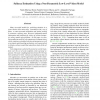Free Online Productivity Tools
i2Speak
i2Symbol
i2OCR
iTex2Img
iWeb2Print
iWeb2Shot
i2Type
iPdf2Split
iPdf2Merge
i2Bopomofo
i2Arabic
i2Style
i2Image
i2PDF
iLatex2Rtf
Sci2ools
CVPR
2011
IEEE
2011
IEEE
Saliency Estimation Using a Non-Parametric Low-Level Vision Model
Many successful models for predicting attention in a scene involve three main steps: convolution with a set of filters, a center-surround mechanism and spatial pooling to construct a saliency map. However, integrating spatial information and justifying the choice of various parameter values remain open problems. In this paper we show that an efficient model of color appearance in human vision, which contains a principled selection of parameters as well as an innate spatial pooling mechanism, can be generalized to obtain a saliency model that outperforms state-of-the-art models. Scale integration is achieved by an inverse wavelet transform over the set of scale-weighted center-surround responses. The scale-weighting function (termed ECSF) has been optimized to better replicate psychophysical data on color appearance, and the appropriate sizes of the centersurround inhibition windows have been adjusted by training a Gaussian Mixture Model on eye-fixation data, thus avoiding ad-hoc pa...
Related Content
| Added | 20 Mar 2011 |
| Updated | 29 Apr 2011 |
| Type | Journal |
| Year | 2011 |
| Where | CVPR |
| Authors | Naila Murray, Maria Vanrell, Xavier Otazu, C. Alejandro Parraga |
Comments (0)

